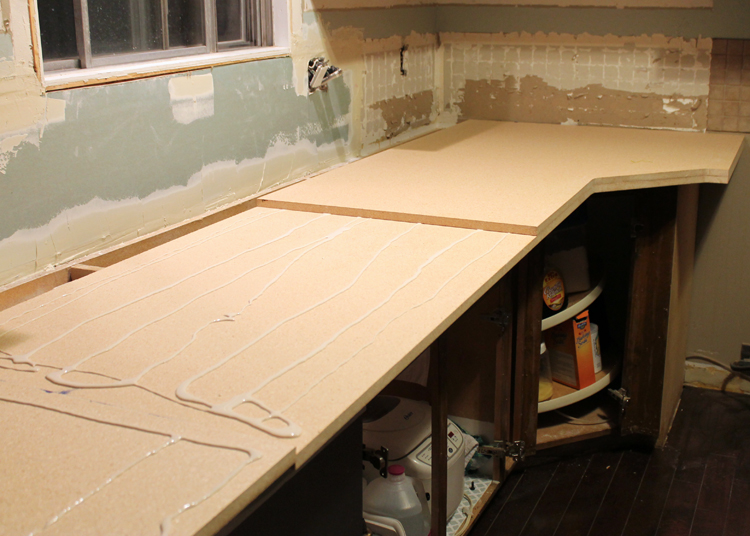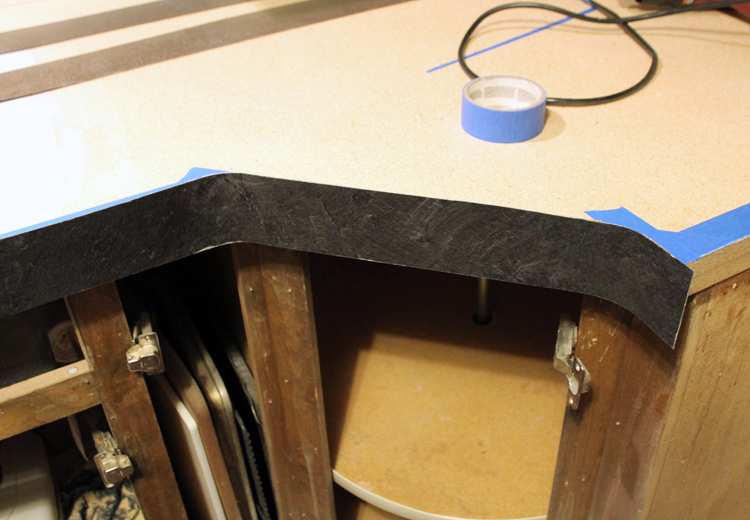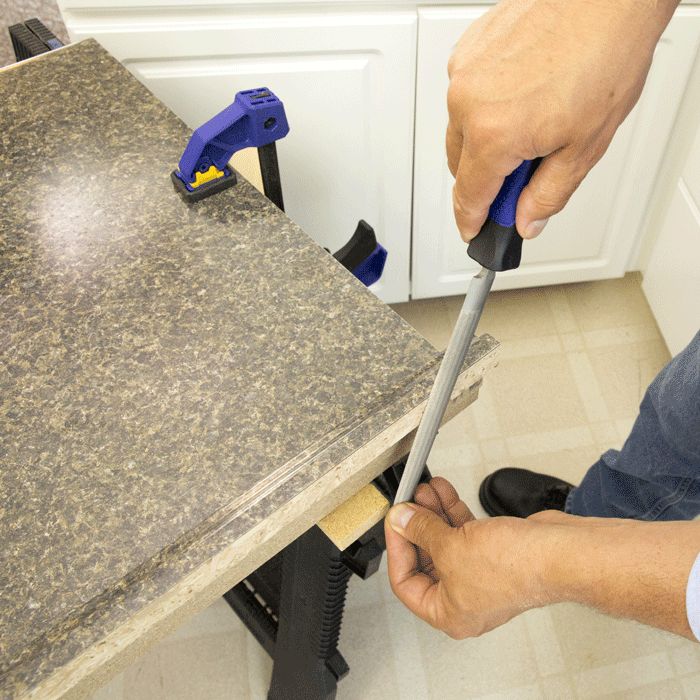Installing laminate countertops yourself can be a highly rewarding project, transforming your kitchen or bathroom at a fraction of the cost of professional installation. The process involves several key steps, from measuring and cutting to gluing and finishing. It’s crucial to start with accurate measurements. Measure the length and width of your existing countertops or the space where the new countertop will be installed. Always double-check these dimensions to avoid costly mistakes. Additionally, ensure you have all the necessary tools and materials before beginning. These typically include a circular saw, jigsaw, router, contact cement, screws, sandpaper, and the laminate itself.
Once you have your measurements, the next step is to cut the laminate and the substrate, which is usually particleboard or MDF (medium-density fiberboard). Use a straight edge and a circular saw with a fine-tooth blade to make clean cuts. Precision is vital here; even a slight miscalculation can lead to uneven edges or improper fit. For sink cutouts or other intricate shapes, a jigsaw is more suitable. Always wear safety goggles and gloves when cutting, and work in a well-ventilated area to avoid inhaling sawdust.
After cutting the substrate, it’s time to apply the laminate. Begin by applying contact cement to both the substrate and the back of the laminate sheet. Allow the cement to become tacky as per the manufacturer’s instructions, usually around 15 to 20 minutes. Carefully align the laminate sheet with the substrate and press it firmly into place. Using a J-roller, apply consistent pressure across the entire surface to ensure a strong bond and to eliminate air bubbles. Trim any excess laminate using a router with a flush-trim bit, ensuring smooth edges.
For the edges of your countertop, you can use pre-fabricated laminate strips or cut your own from a larger sheet. Apply contact cement to both the edge strips and the countertop edges, let it become tacky, then press the strips in place. Again, use a J-roller to ensure a secure bond. Once the edges are affixed, use a router to trim any overhang, and then smooth the edges with fine-grit sandpaper. This step is essential for achieving a professional look and feel.

Installing the countertop requires precise positioning. Dry-fit the countertop first to ensure it fits perfectly in place. If any adjustments are needed, make them before applying adhesive. Once you are satisfied with the fit, apply a bead of silicone caulk or construction adhesive to the top edges of the base cabinets. Carefully position the countertop on top, pressing down firmly. Secure the countertop from underneath by screwing it into the cabinet frames.
If your project includes a sink installation, this can be a bit more complex. Place the sink upside down on the countertop to trace its outline, then cut out the opening using a jigsaw. It’s important to support the cutout section to prevent the laminate from chipping or cracking. After cutting, apply a waterproof sealant around the edge of the sink cutout. Place the sink into the opening, securing it with the provided clips or brackets, and connect the plumbing fixtures.
Once the countertop is securely installed, finish the project by caulking the seams and edges. This will prevent water from seeping under the laminate and causing damage. Use a high-quality silicone caulk for a watertight seal. Smooth the caulk with a wet finger or a caulking tool for a professional finish. Allow the caulk to cure completely before using the countertop.

Throughout the installation process, maintaining a clean work environment is crucial. Regularly remove dust and debris to prevent any obstructions or inaccuracies. It’s also important to regularly check your progress and alignment. Small errors can accumulate, leading to larger issues down the line. Take your time, and don’t rush any step. Patience and precision are key to a successful DIY laminate countertop installation.
One often overlooked aspect of countertop installation is the backsplash. If your design includes a laminate backsplash, follow similar steps for cutting, adhering, and finishing. Ensure that the seams between the countertop and backsplash are properly caulked to prevent water damage. A well-installed backsplash not only adds to the aesthetic appeal but also enhances the functionality of the countertop by protecting the wall from spills and splashes.
Proper ventilation is important when working with adhesives like contact cement. The fumes can be quite strong and potentially harmful if inhaled in large amounts. Always work in a well-ventilated area and consider using a respirator mask. Additionally, follow all safety instructions on the product labels to avoid accidents and ensure a safe working environment.
Laminate countertops are known for their durability and ease of maintenance. However, to keep them looking new, avoid placing hot pots and pans directly on the surface, as extreme heat can cause the laminate to scorch or bubble. Use trivets or heat-resistant pads instead. Also, avoid cutting directly on the countertop to prevent scratches. Use a cutting board to maintain the surface’s integrity.

Cleaning laminate countertops is straightforward. A mild detergent or a vinegar-water solution is usually sufficient for daily cleaning. Avoid using abrasive cleaners or scouring pads, as these can damage the laminate surface. For stubborn stains, a baking soda paste can be effective. Apply the paste to the stain, let it sit for a few minutes, then gently scrub with a soft cloth and rinse thoroughly.
Proper maintenance can extend the life of your laminate countertop significantly. Regularly inspect the seams and edges for any signs of lifting or damage. Promptly repair any minor issues before they become major problems. If you notice any bubbling or warping, it may be due to moisture getting under the laminate. Address these issues immediately to prevent further damage.
Laminate countertops come in a wide variety of colors and patterns, allowing you to customize the look to match your kitchen or bathroom decor. From realistic stone and wood patterns to solid colors, the options are extensive. When selecting your laminate, consider both aesthetics and durability. Some laminates are more resistant to scratches and stains than others, so choose one that fits your needs and lifestyle.
The environmental impact of your project is another consideration. Many modern laminates are made with eco-friendly materials and processes. Look for products that have low VOC emissions and are made from recycled materials if sustainability is important to you. Additionally, consider the disposal of any old countertops or leftover materials. Recycle or repurpose them whenever possible to reduce waste.

How long does it typically take to install a laminate countertop?
The time required for DIY laminate countertop installation can vary widely depending on the size and complexity of the project, as well as your experience level. For a standard kitchen, you can expect to spend several days on the project, including time for measuring, cutting, adhering, and finishing. Preparation and drying times for adhesives also add to the overall timeline. Rushing through any step can lead to mistakes, so it’s essential to allow ample time for each phase of the installation.
Can I install a laminate countertop over an existing countertop?
Yes, it is possible to install a new laminate countertop over an existing one, provided the old countertop is in good condition and properly prepared. The existing surface should be clean, dry, and free of any damage or irregularities. Sanding the old countertop to create a rough surface can help the new laminate adhere better. However, be aware that this method can add height to your countertop, which might affect the fit and appearance of your kitchen or bathroom fixtures.
What type of adhesive should I use for laminate countertops?
Contact cement is the most commonly used adhesive for laminate countertops. It creates a strong, durable bond between the laminate and the substrate. Follow the manufacturer’s instructions for application, which typically involve applying the adhesive to both surfaces and allowing it to become tacky before bonding. Ensure adequate ventilation when using contact cement, as the fumes can be quite strong. Other adhesives, like construction adhesive or silicone caulk, may be used for securing the countertop to the cabinets and sealing seams.

How do I handle seams in a laminate countertop installation?
Handling seams in laminate countertops requires precision and care to ensure a seamless appearance. Use a router to create clean, straight edges on both pieces of laminate. Apply contact cement to the edges and press them together, using a J-roller to eliminate any air bubbles. Once the seams are joined, use fine-grit sandpaper to smooth out any roughness. Applying a color-matched seam filler can help blend the seam with the rest of the countertop, making it less noticeable.
Can I install a laminate countertop by myself, or do I need help?
While it is possible to install a laminate countertop by yourself, having an extra set of hands can be highly beneficial, especially for larger or more complex projects. Aligning large sheets of laminate and positioning the countertop accurately can be challenging alone. A helper can assist with holding materials in place, applying pressure during bonding, and ensuring everything is level and secure. If you do decide to tackle the project solo, take your time and plan each step carefully to avoid mistakes.
How do I maintain and care for my laminate countertop?
Maintaining a laminate countertop involves regular cleaning with mild detergents or a vinegar-water solution. Avoid abrasive cleaners or scouring pads, which can damage the surface. Use trivets or heat-resistant pads to protect the countertop from hot pots and pans, and always use a cutting board to prevent scratches. Regularly inspect the seams and edges for signs of damage, and promptly repair any issues to prevent further deterioration. With proper care, a laminate countertop can remain attractive and functional for many years.

How To Install Sheet Laminate On A Countertop

How to Install Laminate on Countertops how-tos DIY

How to Install Laminate Countertops

Building DIY WOOD COUNTERTOPS from PLYWOOD

DIY Laminate Countertops for a Home Office – Printable Crush

Related articles:
- Painting Kitchen Laminate Countertops
- Quartz Laminate Countertops
- Laminate Countertops Installation
- Laminate Countertop For Kitchen Island
- Kitchen Island Laminate Countertops
- Cheap Laminate Countertops
- Laminate Countertops That Look Like Stone
- Plastic Laminate Countertops
- Laminate Countertop Ideas For Kitchen
- Dark Green Laminate Countertops